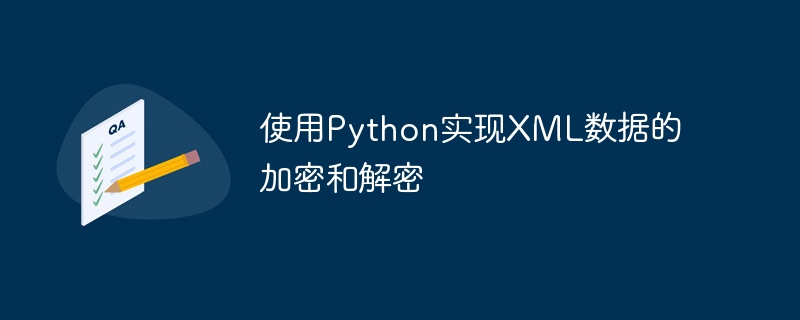Home >Backend Development >Python Tutorial >Encrypting and decrypting XML data using Python
Encrypting and decrypting XML data using Python
- PHPzOriginal
- 2023-08-08 08:34:511871browse

Use Python to implement encryption and decryption of XML data
Introduction:
In the modern information age, data security is crucial. For sensitive data, we often need to use various encryption algorithms to protect its confidentiality. As a common data format, XML also requires a certain encryption mechanism to ensure its security. This article will introduce how to use Python to encrypt and decrypt XML data.
1. Introduction to XML
XML (eXtensible Markup Language), extensible markup language, is a commonly used data exchange format. XML describes the data structure through tags and has the characteristics of good readability, easy parsing and flexible data format. Therefore, it is widely used in fields such as Web services, data storage and data transmission.
2. Introduction to Encryption Algorithm
This article uses the AES (Advanced Encryption Standard) algorithm to encrypt and decrypt XML data. AES is a symmetric encryption algorithm mainly used to replace the DES (Data Encryption Standard) algorithm. The AES algorithm has fast encryption speed and high-strength security.
3. Python implementation code example
The following is a code example using python to implement XML data encryption and decryption:
- Encryption process:
from Crypto.Cipher import AES
import base64
def pad(s):
return s + (16 - len(s) % 16) * chr(16 - len(s) % 16)
def encrypt(xml_data, key):
cipher = AES.new(key.encode('utf-8'), AES.MODE_ECB)
encrypted_data = cipher.encrypt(pad(xml_data).encode('utf-8'))
return base64.b64encode(encrypted_data).decode('utf-8')
xml_data = '''
<?xml version="1.0" encoding="UTF-8"?>
<root>
<name>John</name>
<age>25</age>
</root>
'''
key = '0123456789abcdef' # 密钥必须为16、24或32字节长(注意:此处密钥为示例,实际应使用更复杂的密钥)
encrypted_xml = encrypt(xml_data, key)
print(encrypted_xml)- Decryption process:
def unpad(s):
return s[:-ord(s[len(s) - 1:])]
def decrypt(encrypted_data, key):
cipher = AES.new(key.encode('utf-8'), AES.MODE_ECB)
decrypted_data = cipher.decrypt(base64.b64decode(encrypted_data.encode('utf-8')))
return unpad(decrypted_data.decode('utf-8'))
decrypted_xml = decrypt(encrypted_xml, key)
print(decrypted_xml) IV. Summary
This article introduces how to use Python to encrypt and decrypt XML data. By using the AES algorithm, we can protect the security of XML data well. In practical applications, we should choose appropriate encryption algorithms and encryption parameters according to needs to ensure data security and reliability.
For more information about Python’s encryption and decryption technology, as well as XML data processing methods, please refer to relevant documents and information. I hope this article is helpful to you, thank you for reading!
The above is the detailed content of Encrypting and decrypting XML data using Python. For more information, please follow other related articles on the PHP Chinese website!

